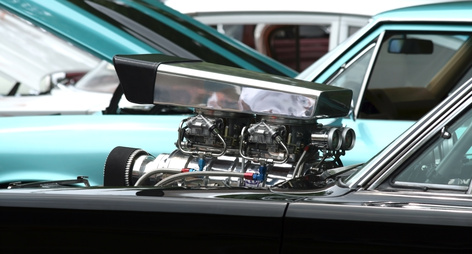
Technically speaking, no difference exists between a supercharger and a blower; "blower" is slang for any device that pushes more air into an engine than it could ingest alone. However, recent years have witnessed a divergence in technologies that has led many to call turbochargers, and some types of superchargers, "blowers," while other types of superchargers are still referred to by their proper name.
Engines make power by burning fuel; the more fuel the engine burns the more power it makes. Fuel requires oxygen to combust, so anything that helps the engine to inhale more air will make power. Superchargers and blowers are air compressors that forcibly feed the engine more air than it would otherwise be able to use.
Two basic types of air compressor are in use today: positive displacement compressors and centrifugal compressors. Positive displacement compressors are like hydraulic pistons in that they'll (theoretically) move the same amount of air per revolution regardless of speed. Centrifugal compressors (like turbos) use fast-spinning impeller blades to shove air against the walls, shaped like a snail shell, of the compressor housing. The air squishes against the walls and squirts out of the housing through an opening. Today, positive displacement compressors are always referred to as superchargers and everything else is called a blower.
Positive displacement compressors do their best work at low RPM, making for huge torque and instant throttle response. However, they begin to lose efficiency and heat the air at high RPMs resulting in lost power and increased risk of engine knock. Centrifugal compressors do practically nothing at low RPM but are very efficient once they get up to speed.
Centrifugal compressors take very little power to turn, which is why turbochargers use them exclusively. Turbos rely on exhaust gas pressure to spin the compressor blades. Such pressure wouldn't stand a chance of running the internals of a positive displacement compressor. Positive displacement superchargers can sap huge amounts of power. Top-fuel dragsters make between 8,000 and 10,000 horsepower, but they require about 500 horsepower just to turn their huge superchargers. All else being equal, a centrifugal blower will make more top-end horsepower than a similar positive displacement supercharger.
Power lost at the crankshaft means there's less to move the car down the road. Anything that sucks power from the crankshaft will hurt fuel economy, which is why cars with positive displacement superchargers will always get worse fuel mileage than those with centrifugal blowers. This is especially true for turbos, which require no extra power output from the engine whatsoever. Their power derives from heat and pressure that would otherwise go to waste.